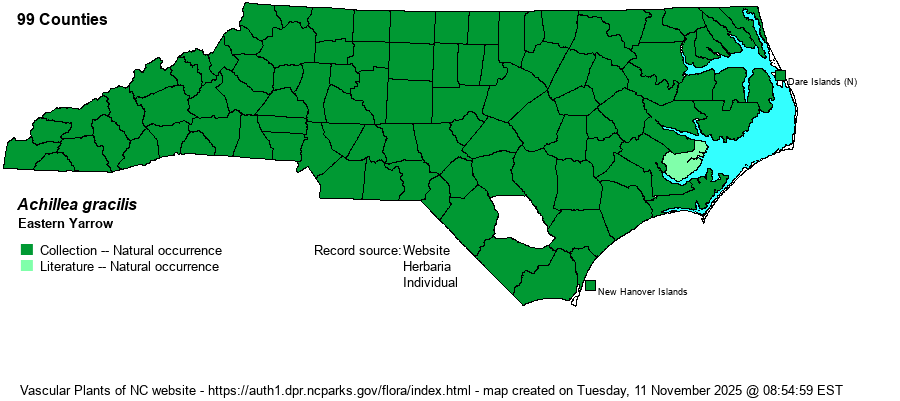| Author | Rafinesque | |
| Distribution | Throughout the state, certainly found in all 100 counties. Apparently, no one has bothered to collect or photograph it from Bladen County. Eastern Yarrow is one of our most widely distributed plant species, but it is scarce in poor sandy soils.
Throughout eastern North America, and into Mexico. A different species -- A. borealis -- is found in the western U.S. | |
| Abundance | Common to locally abundant in all three provinces. | |
| Habitat | Mostly disturbed sites, such as dry to mesic roadsides, yards, fields, cultivated ground, pastures, and waste places. Also in more natural sites, such as rock outcrops, grassy balds, and woodland openings. |
| Phenology | Flowering and fruiting April-October. | |
| Identification | No doubt familiar to most naturalists, Eastern Yarrow stems are mostly 1-2 feet tall, with a terminal, flattish, white inflorescence and alternate, 2-3 times pinnately dissected leaves. The leaves are cut into a pattern that is unique in our flora, even finer than in nearly all ferns, more like a green bird feather. | |
| Taxonomic Comments | The Achillea millefolium complex is distributed throughout the Northern Hemisphere and has resisted attempts to classify it. Weakley (2018) cites a 2009 publication that splits off North American plants and we follow his lead. Though most references consider the species as a non-native one in most of the East, Weakley (2018, 2024) and others consider it native. Apparently the earliest name for the native entity is A. gracilis Rafinesque; Weakley (2022) now uses this name, instead of A. borealis.
| |
| Other Common Name(s) | Common Yarrow, American Yarrow, Boreal Yarrow | |
| State Rank | S5 | |
| Global Rank | G5 | |
| State Status | | |
| US Status | | |
| USACE-agcp | | |
| USACE-emp | | |

